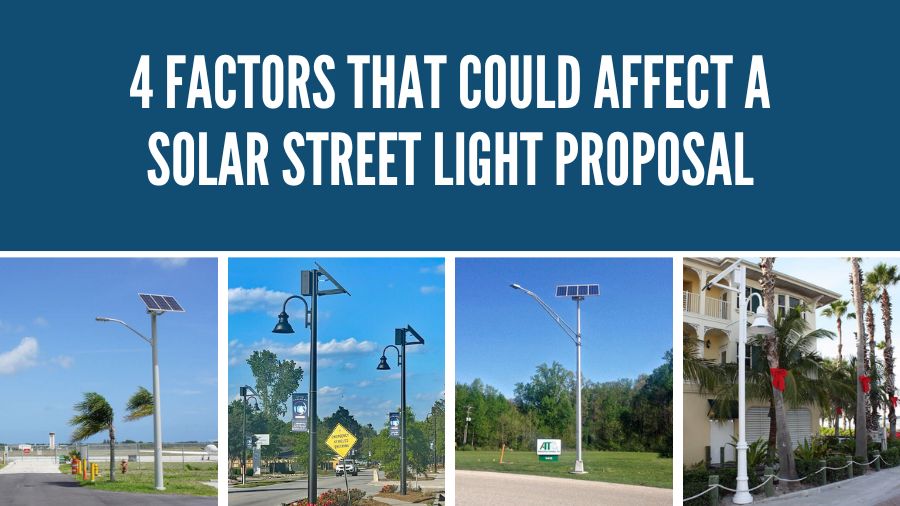


There are many factors to consider when creating a solar street light proposal. Only a few people know all the considerations required, but here is a list of little-known factors that can make the specification process less stressful. With this information, you will be able to create a better specification and ensure that solar is the right fit for your application. Let's dive in.
When working on a street, parking lot, or pathway project, understanding active hours is crucial in determining how long per night the lights need to be on at full output. Not all areas require the lights to be on at full from dusk to dawn, and reducing them when traffic patterns are less, can reduce the size of the solar requirement. For this, there are a couple of questions to ask:
If there is little to no activity between 1 am and 5 am, and there are no safety concerns with lowering the fixture's wattage to conserve energy, you can use adaptive lighting techniques. Adaptive lighting can reduce fixture wattage during a specific period, reducing the solar required to operate the fixture. Reducing the overall load can lower the overall project costs.
Adaptive lighting should not be used if the activity is steady throughout the night, say on a main roadway. Instead, dusk to dawn operation would be required with maintained lighting output. Having maintained lighting is not an option with many off-the-shelf lighting systems and should be noted when doing a system design.
Finally, if the lighting can reduce when traffic is low, but there are shifts or some other reason that lights would need to be increased at random times, then adaptive lighting with motion sensing is a great way to both save on solar and have lighting adequate for when activity increases again.
Is the roadway, or other space, covered in trees? Or maybe it is surrounded by tall buildings. Having anything taller in the east, south, or west of the solar panel can be detrimental to the production of solar energy. This is because the sun is always in the southern hemisphere (northern if you live below the equator), and the solar panels need direct sunlight to produce energy at their fullest capacity.
In situations where obstructions are present and are casting shade, and traditional tree trimming methods prove to be ineffective, our advanced systems can be expertly installed up to 100 feet away from the powering equipment. This ensures that the solar will be provided adequate charge during the day, allowing it to operate the light at night per the required operation.
The light level requirements are usually decided by either municipal codes or by the IESNA for lighting standards. Depending on the lighting requirements and how large the area is can determine how many solar street lights are provided with the proposal. With aimed optics, we are able to tailor the lights to the installation to ensure plenty of coverage. In many cases, we are able to reduce the number of lights required in comparison to old-style fixtures. Not only does this lower the project proposal, but it can also reduce the installation costs as well.
For example, typical fixture spacing is around 100' between each light fixture on a standard two-lane roadway. Raise the light fixtures a few feet, and you can get maybe 125-130' spacing. Lower the fixtures closer to the ground, and you may only get 75' between poles. Depending on the installation location, project constraints, and the width of the roadway, this can vary greatly.
Having a complete lighting analysis performed by an engineer using IES files and providing complete lighting layouts will show you exactly the amount of light provided by the systems and the spacing required for your project. Make sure you have this analysis completed in the design phase so that the project scope can be narrowed down early on.
Are there specified mounting requirements such as wind loading or height of poles / fixture brackets? This can be common with many locations, especially near airports, coastal areas, or other restricted areas. Understanding project restrictions is an important part of designing a solar street lighting project and can affect the outcome of the system setup.
Making sure your solar is mounted to the appropriate pole can change many aspects of the proposal. Wind loading ratings are used in a variety of areas, especially those prone to large storms or hurricanes. Having a high wind load rating will provide a lasting light no matter what Mother Nature throws at you. Yes, having these larger poles can affect a system's pricing structure; however, having the peace of mind that the pole will still be okay after a big storm can make the increased cost well worth it.
Mounting height restrictions are also taken into consideration. There are many areas where mounting height restrictions come into play. Since the solar must be mounted at the top of the pole, the fixture typically mounts a few feet below the solar. This means that if you have a restriction of 20', the fixture will mount around 15-18' above grade. Make sure there are no restrictions in your area when designing a system.
With all the parts of a solar street light proposal, ensuring all aspects are covered will ensure you get the most accurate proposal available. Talk to your solar lighting professional, and don't be afraid to ask questions. The more information gathered on the project, the better the proposal will be completed.
